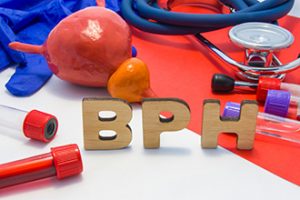Benign Prostatic Hyperplasia
With the prostate, there are usually two main issues: benign prostatic hyperplasia and prostate cancer. For men older than 50, benign prostatic hyperplasia (BPH) is the most frequent prostate issue. BPH, also called an enlarged prostate, means a non-cancerous increase in the number and size of prostate cells — so basically, it is an unhealthy increase in prostate size. While what triggers BPH isn’t well understood, it is believed that factors such as aging, inflammation, fibrosis and hormonal changes are the causes of the condition.
An enlarged prostate presses hard on the urethra and makes urination difficult. In men with the condition, symptoms include:
- Frequent urination, particularly at night.
- Difficulty starting a urine stream.
- Dribbling after passing urine.
- Weak urine stream, or a stream that starts and stops.
- Inability to empty the bladder completely.
But BPH also may have rare and more severe symptoms like:
- Urinary tract infection
- Blood in urine
- Inability to urinate
Prostate cancer
Prostate cancer is another frequent condition in men. In fact, it is the most common cancer after skin cancer, with about 1-in-6 American men being diagnosed with the disease during his lifetime. And like BPH, the cancer is most common in older men, with two-thirds of men diagnosed with the condition usually over age 65.
The cause of prostate cancer isn’t clear, but risk factors include age, family history, race and diet. The cancer grows slowly and rarely shows symptoms, so most men may never know that they have developed the disease until it is in advanced stage. But that also means only around 1-in-35 men with the cancer dies of the disease. Nevertheless, while some prostate cancers grow slowly and often require no or minimal treatment, there are other types that are quite aggressive and spread really quickly.
When caught early, there is a better chance of successfully treating the cancer. However, since it has similar symptoms to BPH, the condition is quite difficult to diagnose and by the time men see blood in their urine or feel chronic pain in their thighs, hips or lower back, it is often quite late. That is why it is critical for men of average to high risk of the cancer to have annual screening as early as appropriate.
Actually, for men of average risk of prostate cancer, the discussion to begin screening should start at the age of 50. While for those of higher risk, it is prudent to begin this discussion a little earlier, though not earlier than 40. But before screening, it is vital to discuss the risks and benefits of the testing with the doctor so the test offered meets the personal preferences and values of the patient.
For more information on prostate problems and how to prevent, diagnose and treat them, visit the “St Pete Urology” site.



 When using a prescription for managing enlarged prostate, you will take the pills every day for life, have regular medical checkups, and use special bathroom techniques such as relaxation and double voiding. The medicines will reduce the risk of urinary retention, relieve symptoms and minimize risks of future surgery. However, prescriptions are often expensive and come with certain side effects such as trouble getting an erection, diminished sex drive, tiredness, dizziness, and stuffy nose.
When using a prescription for managing enlarged prostate, you will take the pills every day for life, have regular medical checkups, and use special bathroom techniques such as relaxation and double voiding. The medicines will reduce the risk of urinary retention, relieve symptoms and minimize risks of future surgery. However, prescriptions are often expensive and come with certain side effects such as trouble getting an erection, diminished sex drive, tiredness, dizziness, and stuffy nose.